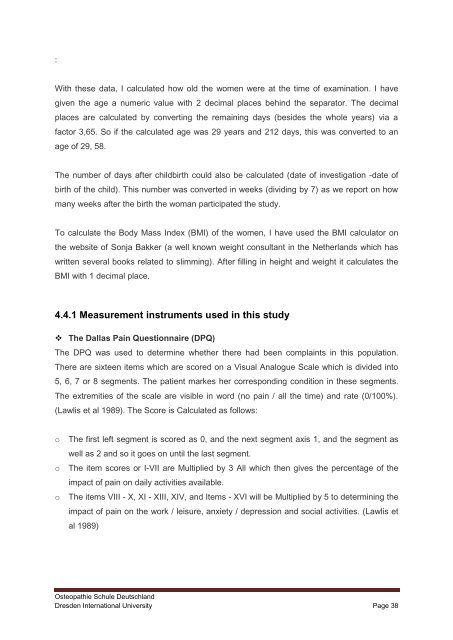Pelvic girdle pain and relevance of ASLR testing: A ... - Cindy Verheul
Pelvic girdle pain and relevance of ASLR testing: A ... - Cindy Verheul
Pelvic girdle pain and relevance of ASLR testing: A ... - Cindy Verheul
Create successful ePaper yourself
Turn your PDF publications into a flip-book with our unique Google optimized e-Paper software.
:<br />
With these data, I calculated how old the women were at the time <strong>of</strong> examination. I have<br />
given the age a numeric value with 2 decimal places behind the separator. The decimal<br />
places are calculated by converting the remaining days (besides the whole years) via a<br />
factor 3,65. So if the calculated age was 29 years <strong>and</strong> 212 days, this was converted to an<br />
age <strong>of</strong> 29, 58.<br />
The number <strong>of</strong> days after childbirth could also be calculated (date <strong>of</strong> investigation -date <strong>of</strong><br />
birth <strong>of</strong> the child). This number was converted in weeks (dividing by 7) as we report on how<br />
many weeks after the birth the woman participated the study.<br />
To calculate the Body Mass Index (BMI) <strong>of</strong> the women, I have used the BMI calculator on<br />
the website <strong>of</strong> Sonja Bakker (a well known weight consultant in the Netherl<strong>and</strong>s which has<br />
written several books related to slimming). After filling in height <strong>and</strong> weight it calculates the<br />
BMI with 1 decimal place.<br />
4.4.1 Measurement instruments used in this study<br />
The Dallas Pain Questionnaire (DPQ)<br />
The DPQ was used to determine whether there had been complaints in this population.<br />
There are sixteen items which are scored on a Visual Analogue Scale which is divided into<br />
5, 6, 7 or 8 segments. The patient markes her corresponding condition in these segments.<br />
The extremities <strong>of</strong> the scale are visible in word (no <strong>pain</strong> / all the time) <strong>and</strong> rate (0/100%).<br />
(Lawlis et al 1989). The Score is Calculated as follows:<br />
o The first left segment is scored as 0, <strong>and</strong> the next segment axis 1, <strong>and</strong> the segment as<br />
well as 2 <strong>and</strong> so it goes on until the last segment.<br />
o The item scores or I-VII are Multiplied by 3 All which then gives the percentage <strong>of</strong> the<br />
impact <strong>of</strong> <strong>pain</strong> on daily activities available.<br />
o The items VIII - X, XI - XIII, XIV, <strong>and</strong> Items - XVI will be Multiplied by 5 to determining the<br />
impact <strong>of</strong> <strong>pain</strong> on the work / leisure, anxiety / depression <strong>and</strong> social activities. (Lawlis et<br />
al 1989)<br />
Osteopathie Schule Deutschl<strong>and</strong><br />
Dresden International University Page 38


